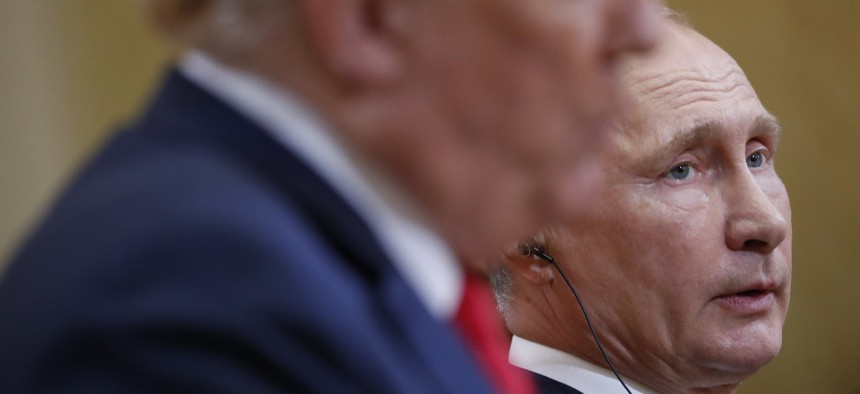
Russian President Vladimir Putin, right, listens to U.S. President Donald Trump, right, speak during their joint news conference at the Presidential Palace in Helsinki, Finland, Monday, July 16, 2018. AP Photo/Pablo Martinez Monsivais
The Helsinki Move That Could Save the INF Treaty
Putin offered suggestions for strategic stability. The U.S. should respond with proposals to revive verification.
Amid President Donald Trump’s performance in Helsinki, you’d be forgiven if you didn’t pick up on some nuclear diplomacy by his Russian counterpart. “It’s crucial that we fine-tune the dialogue on strategic stability and global security,” Vladimir Putin said at the leaders’ post-meeting press conference. “We submitted [to] our American colleagues a note with a number of specific suggestions.”
That note — diplo-speak for a formal communication between governments — likely contains the Russian position on a number of key nuclear treaties, from the New START Treaty limiting strategic arsenals, to the Outer Space Treaty banning nuclear weapons in orbit. Most importantly, however, the note could represent a chance to save one of the most historically successful arms control agreements to date: the Intermediate-Range Nuclear Forces Treaty.
In the mid-1970s, the nuclear threat to Europe reached an inflection point. The new Soviet intermediate-range missile, the SS-20, was a quantum leap over its predecessors in range, explosive yield, and time needed to fire. In response to its deployment, the United States adopted a “dual-track” strategy: pumping its own intermediate-range missiles into Europe while aggressively pursuing talks on the issue.
Fortunately, the two sides found a diplomatic solution to this nuclear standoff. In 1987, President Ronald Reagan and Soviet Premier Mikhail Gorbachev signed the INF Treaty, permanently banning ground-launched ballistic and cruise missiles with a range between 500 and 5,000 kilometers. Thousands of intermediate-range missiles were dismantled on each side by 1991, while mutual inspections continued for a decade thereafter.
Related: Moscow Has Little Reason to Return to the INF Treaty
Related: Russia Has Deployed a Treaty-Violating Missile. Here’s What the US Should Do About It
Related: Pentagon Confirms It’s Developing Nuclear Cruise Missile to Counter a Similar Russian One
Despite its successful past, the INF Treaty is now in danger. In 2014, the Obama administration declared that Russia had tested an intermediate-range cruise missile prohibited under the deal. But it didn’t end there. Two years later, U.S. officials disclosed that Moscow had increased production of these “small, mobile, and easily concealed” missiles, before ultimately announcing in March 2017 that the weapons had been deployed. “I don’t have enough information on [the Russians’] intent to conclude,” Gen. Paul Selva, vice chairman of the Joint Chiefs of Staff, told Congress, “other than that they do not intend to return to compliance."
Washington’s growing anxiety is understandable. “The [INF] Treaty confers enormous advantages on the United States in defending its European allies,” said Stephen Sestanovich, a senior fellow at the Council on Foreign Relations. Without it, battalions of intermediate-range missiles could “sit back” in Russia, threatening European cities while remaining safely out of range of all but the most determined NATO responses.
In its recent attempts to cajole Russia back into compliance, the United States has mainly relied on complaints and vague threats. In December, the Trump administration announced their decision to review “military concepts and options,” while the 2018 Nuclear Posture Review warned that “the United States will not forever endure Russia’s continuing noncompliance” on intermediate-range nuclear missiles.
So far, this policy isn’t working, but neither will a return to the old “dual-track” strategy. The military aspect of that approach requires weapons that currently don’t exist in the U.S. arsenal, and in the meantime Moscow is likely to be worried more by Chinese missiles on the ground than American missiles on the drawing board. This leaves an aggressive diplomatic push as the one avenue immediately available if the INF Treaty is to be saved.
Luckily, one such solution exists. The INF Treaty provides for a Special Verification Commission, designed specifically by the parties to “resolve questions relating to compliance.” The United States should use this commission to demand a return to on-site inspections—a provision of the treaty that expired in 2001. These on-site inspections could involve a demonstration of the Russian missiles in question, compelling Moscow to choose between destroying their intermediate-range weapons and breaking openly with the nuclear agreement (a step they seem reluctant to take).
For their part, Russian teams would be granted access to U.S. missile defense sites in Europe—which the Kremlin alleges are capable of firing intermediate-range missiles. Both parties would gain assurance of the other’s INF Treaty compliance, and the security benefits gained would be immense. The United States could remove a particularly nasty thorn from its eastern NATO flank, while Russia could ensure that the new generation of American intermediate-range nuclear missiles remains stillborn.
Will Russia bite? That may depend on what Putin wrote in his note. But it’s not impossible that they do. After all, Moscow knows it cannot keep American intermediate-range missiles away from Europe forever if it continues along its current path. And fear of that outcome, as it did in the 1980s, might prove decisive.